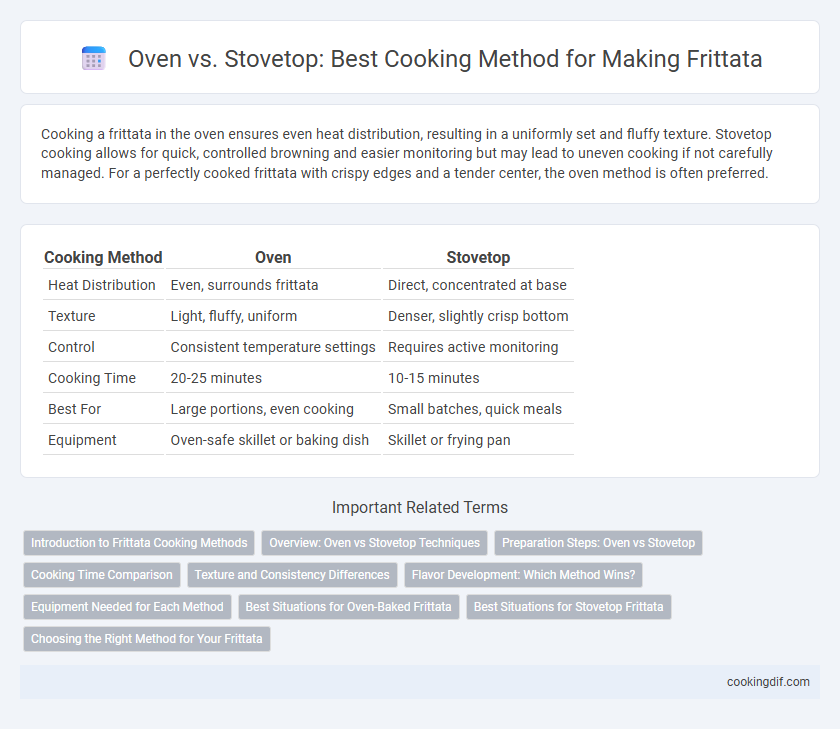Cooking a frittata in the oven ensures even heat distribution, resulting in a uniformly set and fluffy texture. Stovetop cooking allows for quick, controlled browning and easier monitoring but may lead to uneven cooking if not carefully managed. For a perfectly cooked frittata with crispy edges and a tender center, the oven method is often preferred.
Table of Comparison
| Cooking Method | Oven | Stovetop |
|---|---|---|
| Heat Distribution | Even, surrounds frittata | Direct, concentrated at base |
| Texture | Light, fluffy, uniform | Denser, slightly crisp bottom |
| Control | Consistent temperature settings | Requires active monitoring |
| Cooking Time | 20-25 minutes | 10-15 minutes |
| Best For | Large portions, even cooking | Small batches, quick meals |
| Equipment | Oven-safe skillet or baking dish | Skillet or frying pan |
Introduction to Frittata Cooking Methods
Frittatas can be cooked using both oven and stovetop methods, each offering distinct advantages. Oven baking ensures even heat distribution, resulting in a fully cooked, fluffy texture, while stovetop cooking allows for quick preparation and easy monitoring. Understanding these methods helps optimize the cooking process based on desired texture and convenience.
Overview: Oven vs Stovetop Techniques
Oven cooking for frittatas ensures even heat distribution, resulting in a uniformly cooked, fluffy texture with a golden-brown top. Stovetop techniques offer quicker cooking times and greater control over browning but may require careful attention to avoid uneven cooking or burning. Combining both methods--starting on the stovetop and finishing in the oven--maximizes flavor development and desired consistency.
Preparation Steps: Oven vs Stovetop
Cooking frittata in the oven involves sauteing ingredients on the stovetop first, then transferring the skillet to a preheated oven at 350degF (175degC) for 15-20 minutes until fully set and slightly golden. Stovetop preparation requires gently cooking the egg mixture over low heat, often covered, for 10-15 minutes, allowing the frittata to cook through without browning excessively. Oven methods provide even heat distribution and a consistent texture, while stovetop requires attentive heat control to avoid uneven cooking or burning.
Cooking Time Comparison
Oven-cooked frittatas typically require 15 to 20 minutes at 350degF, ensuring even cooking and a firm texture throughout. Stovetop frittatas cook faster, usually taking about 8 to 12 minutes on medium heat, but demand careful attention to avoid burning or uneven cooking. Choosing between methods depends on balancing quicker cooking time on the stovetop with the consistent doneness and ease of baking in the oven.
Texture and Consistency Differences
Oven-cooked frittatas develop a uniform, fluffy texture with a consistently creamy interior due to even heat distribution, while stovetop frittatas often have a denser base and slightly firmer texture from direct heat contact. The oven method allows for gentle setting of eggs without overcooking the edges, preserving moisture throughout. Stovetop cooking requires careful heat control to prevent uneven cooking and possible browning or dryness on the bottom.
Flavor Development: Which Method Wins?
Oven-cooked frittatas develop a more even, custard-like texture with enhanced flavors from gentle, consistent heat, allowing ingredients to meld thoroughly. Stovetop cooking creates a slightly caramelized, crispy bottom that intensifies savory notes through Maillard reactions but may yield uneven cooking. Overall, ovens excel in balanced flavor integration, while stovetops offer bold, localized browning for flavor contrast.
Equipment Needed for Each Method
Oven cooking requires a preheated oven and an oven-safe skillet or baking dish, such as cast iron or ovenproof nonstick pans, to ensure even heat distribution and proper frittata setting. Stovetop preparation demands a high-quality nonstick or cast iron skillet with a tight-fitting lid to facilitate gentle cooking and prevent burning while allowing the eggs to cook through. Both methods benefit from heat-resistant utensils like silicone spatulas for folding and serving without damaging the cookware surfaces.
Best Situations for Oven-Baked Frittata
Oven-baked frittatas are ideal for evenly cooking thicker mixtures or when preparing large servings for gatherings, as the consistent heat ensures a uniform texture without constant attention. Baking in the oven allows for hands-off cooking, perfect when multitasking in the kitchen or when other stovetop burners are occupied. This method excels with ingredients that benefit from slow, steady heat, such as denser vegetables and cheeses, resulting in a crisp golden top and tender interior.
Best Situations for Stovetop Frittata
Stovetop frittatas are ideal for quick meals when constant heat control is necessary to prevent burning or uneven cooking. They work best for small to medium-sized batches and when adding delicate ingredients like fresh herbs or cheese late in the cooking process. This method allows for easy stirring and immediate adjustments, making it perfect for a fast, customizable breakfast or brunch.
Choosing the Right Method for Your Frittata
Oven-baked frittatas provide even heat distribution, yielding a perfectly set and fluffy texture, ideal for thicker mixtures with multiple ingredients. Stovetop cooking offers quicker preparation and more control, suitable for thinner frittatas or when you want a slightly crispy bottom. Selecting the right method depends on your desired texture, ingredient density, and kitchen equipment availability.
Oven vs Stovetop for cooking method Infographic

 cookingdif.com
cookingdif.com